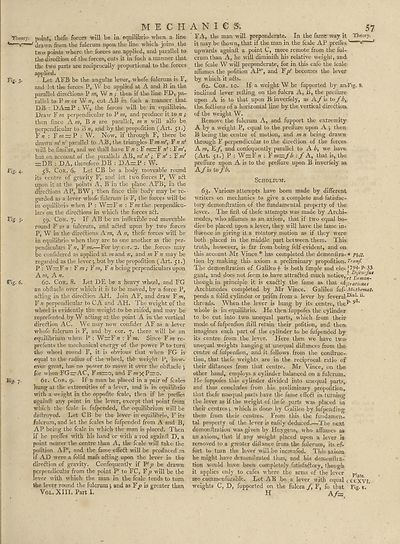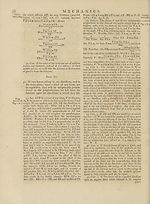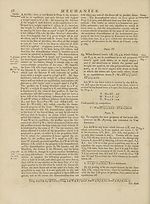Encyclopaedia Britannica, or, a Dictionary of arts, sciences, and miscellaneous literature : enlarged and improved. Illustrated with nearly six hundred engravings > Volume 13, MAT-MIC
(65) Page 57
Download files
Complete book:
Individual page:
Thumbnail gallery: Grid view | List view

MECHANIC S.
57
Theory.
F>S- 3-
%• 4*
f'g- 5*
point, thefe forcc!i will be in equilibrio when a line
drawn from the fulcrum upon the line which joins the
two points where the forces are applied, and parallel to
the direction of the forces, cuts it in luch a manner that
the two parts are reciprocally proportional to the forces
applied.
Let AFB be the angular lever, whofe fulcrum is F,
and let the forces P, W be applied at A and B in the
parallel diredtions P ni^ W n ; then if the line FD, pa¬
rallel to P m or W «, cut AB in luch a manner that
DB : DA=P : W, the forces will be in equilibrio.
Draw F m perpendicular to P m, and produce it to « ;
then lince A m, B n are parallel, m n will alfo be
perpendicular to B », and by the propofition (Art. 51.)
F n : F m — P : W. Now, if through F, there be
drawn m! n' parallel to AB, the triangles F m m', F n n'
will be fxmilar, and we lliall have F « : F m=.Y n': Ym',
but on account of the parallels AB, ni n'; F ?i' : F m'
—DB : DA, therefore DB : DA—P : W.
58. Cor. 6. Let CB be a body moveable round
its centre of gravity F, and let two forces P, W act
upon it at the points A, B in the plane AFB, in the
directions AP, BW; then fince this body may be re¬
garded as a lever whofe fulcrum is F, the forces will be
in equilibrio when P : WrrF n : F ?n the perpendicu¬
lars on the directions in which the forces adt.
59. Cor. 7. If AB be an inflexible rod moveable
round F as a fulcrum, and adled upon by two forces
P, W in the diredtions A m, A n, thefe forces will be
in equilibrio when they are to one another as the per¬
pendiculars F «, F m.—For by cor. 2. the forces may
be confidered as applied at in and «, and m F;/ may be
regarded as the lever •, but by the propofition (Art. 51.)
P : W=rF n : F m ; F ?;/, F n being perpendiculars upon
A m, A n.
Fig. 6. 60. Cor. 8. Let DE be a heavy wheel, and FG
an obflacle over which it is to be moved, by a force P,
adting in the diredtion AH. Join AF, and draw' Y m,
F « perpendicular to CA and AH. The weight of the
wheel is evidently the weight to be raifed, and may be
reprefented by W acting at the point A in the vertical
diredtion AC. We may now confider AF as a lever
whole fulcrum is F, and by cor. 7. there will be an
equilibrium when P : W—F « : F m. Since F m re-
prefents the mechanical energy of the power P to turn
the wheel round F, it is obvious that when FG is
equal to the radius of the wheel, thfe weight P, how¬
ever great, has no power to move it over the obftacle ;
for when FG—AC, F m—Q, and F ttc X P—o.
Big. 7. 61. Cor. 9. If a man be placed in a pair of feales
hung at the extremities of a lever, and is in equilibrio
with a weight in the oppoftte fcale, then if lie prefifes
againft any point in the lever, except that point from
which the fcale is fufpended, the equilibrium will be
deilroyed. Let CB be the lever in equilibrio, F its
fulcrum, and let the feales be fufpended from A and B,
AP being the fcale in which the man is placed. Then
if he preffes with his hand or with a rod againfl D, a
point nearer the centre than A, the fcale will take the
pofition AP', and the fame effedl will be produced as.
if AD were a folid mafs adling upon the lever in the
diredlinn of gravity. Confequently if Vp be drawn
perpendicular from the point P' to FC, Fp will be the
lever with which the man in the fcale tends to turn
fehe lever round the fulcrum j and as Yp is greater than
VoL.Xin.PaA I.
FA, the man will preponderate. In the fame way it Theory,
it may be thown, that if the man in the fcale AP preffes '—--nr"—-'
upwards again It a point C, more remote from the ful¬
crum than A, he will diminilh his relative weight, and
the fcale W will preponderate, for in this cafe the icale
affumes the pofition AP", and Fp' becomes the lever
by which it afts.
62. Cor. 10. If a weight W be fupported by an Fig. &.
inclined lever relting on the fulcra A, B, the preiiure
upon A is to that upon B inverfely, as A/is to fb,
the. feclions of a horizontal line by the vertical direction
of the weight W.
Remove the fulcrum A, and fupport the extremity
A by a weight P, equal to the preiiure upon A j then
B being the centre of motion, and m n being drawn
through F perpendicular to the direction of the forces
A /«, Ey, and confequently parallel to A b, we have
(Art. 51.) P : WrrF n ; F m—fb : f A, that is, the
preflfure upon A is to the preflure upon B inverfely as
A/is to fb.
Scholium.
63. Various attempts have been made by different
writers on mechanics to give a complete and fatisfac-
tory demonflration of the fundamental property of the
lever. The firft of thefe attempts was made by Archi¬
medes, who aflumes as an axiom, that if two equal bo¬
dies be placed upon a lever, they will have the lame in¬
fluence in giving it a rotatory motion as if they were
both placed in the middle part between them. This
truth, however, is far from being fell’ evident, and on
this account Mr Vince * has completed the demonitra- * Phil.
tion by making this axiom a preliminary propolition. Tranf.
The demonftration of Galileo f is both Ample and ele-D94-P-33
gant, and does not feem to have attracted much notice,
though in principle it is exactly the fame as that oijttatiuncs
Archimedes completed by Mr Vince. Galileo fuf- MathemaU
pends a folid cylinder or prifm from a lever by feveral
threads. When the lever is hung by its centre, the*5' 58,
whole is in equilibrio. He then fuppofes the cylinder
to be cut into two unequal parts, which from their
mode of fufpenfion ftill retain their pofition, and then
imagines each part of the cylinder to be fufpended by
its centre from the lever. Here then we have two
unequal weights hanging at unequal diflances from the
centre of fufpenfion, and it follows from the conftruc-
tion, that thefe weights are in the reciprocal ratio of
their diftances from that centre. Mr Vince, on the
other hand, employs a cylinder balanced on a fulcrum.
He fuppofes this cylinder divided into unequal parts,
and thus concludes from his preliminary propofltion,
that thefe unequal parts have the fame effe6t in turning
the lever as if the weight of thefe parts was placed in
their centres ; which is done by Galileo by fufpending
them from their centres. From this the fundamen¬
tal property of the . lever is eafily deduced The next
demonftration was given by Huygens, who aflumes as
an axiom, that if any weight placed upon a lever is
removed to a greater diftance from the fulcrum, its ef¬
fort to turn the lever w ill he increafed. This axiom
he might have demonil rated thus, and his demenftra-
tion would have been completely fatisfactory, though
it applies only to cafes where the arms of the lever p,at<_
are commenfiu-able. Let AB be a lever w ith equal <ecxvi.
weights C, D, fupported on the fulcra /, F, fo that Fig. t.
H Af~
57
Theory.
F>S- 3-
%• 4*
f'g- 5*
point, thefe forcc!i will be in equilibrio when a line
drawn from the fulcrum upon the line which joins the
two points where the forces are applied, and parallel to
the direction of the forces, cuts it in luch a manner that
the two parts are reciprocally proportional to the forces
applied.
Let AFB be the angular lever, whofe fulcrum is F,
and let the forces P, W be applied at A and B in the
parallel diredtions P ni^ W n ; then if the line FD, pa¬
rallel to P m or W «, cut AB in luch a manner that
DB : DA=P : W, the forces will be in equilibrio.
Draw F m perpendicular to P m, and produce it to « ;
then lince A m, B n are parallel, m n will alfo be
perpendicular to B », and by the propofition (Art. 51.)
F n : F m — P : W. Now, if through F, there be
drawn m! n' parallel to AB, the triangles F m m', F n n'
will be fxmilar, and we lliall have F « : F m=.Y n': Ym',
but on account of the parallels AB, ni n'; F ?i' : F m'
—DB : DA, therefore DB : DA—P : W.
58. Cor. 6. Let CB be a body moveable round
its centre of gravity F, and let two forces P, W act
upon it at the points A, B in the plane AFB, in the
directions AP, BW; then fince this body may be re¬
garded as a lever whofe fulcrum is F, the forces will be
in equilibrio when P : WrrF n : F ?n the perpendicu¬
lars on the directions in which the forces adt.
59. Cor. 7. If AB be an inflexible rod moveable
round F as a fulcrum, and adled upon by two forces
P, W in the diredtions A m, A n, thefe forces will be
in equilibrio when they are to one another as the per¬
pendiculars F «, F m.—For by cor. 2. the forces may
be confidered as applied at in and «, and m F;/ may be
regarded as the lever •, but by the propofition (Art. 51.)
P : W=rF n : F m ; F ?;/, F n being perpendiculars upon
A m, A n.
Fig. 6. 60. Cor. 8. Let DE be a heavy wheel, and FG
an obflacle over which it is to be moved, by a force P,
adting in the diredtion AH. Join AF, and draw' Y m,
F « perpendicular to CA and AH. The weight of the
wheel is evidently the weight to be raifed, and may be
reprefented by W acting at the point A in the vertical
diredtion AC. We may now confider AF as a lever
whole fulcrum is F, and by cor. 7. there will be an
equilibrium when P : W—F « : F m. Since F m re-
prefents the mechanical energy of the power P to turn
the wheel round F, it is obvious that when FG is
equal to the radius of the wheel, thfe weight P, how¬
ever great, has no power to move it over the obftacle ;
for when FG—AC, F m—Q, and F ttc X P—o.
Big. 7. 61. Cor. 9. If a man be placed in a pair of feales
hung at the extremities of a lever, and is in equilibrio
with a weight in the oppoftte fcale, then if lie prefifes
againft any point in the lever, except that point from
which the fcale is fufpended, the equilibrium will be
deilroyed. Let CB be the lever in equilibrio, F its
fulcrum, and let the feales be fufpended from A and B,
AP being the fcale in which the man is placed. Then
if he preffes with his hand or with a rod againfl D, a
point nearer the centre than A, the fcale will take the
pofition AP', and the fame effedl will be produced as.
if AD were a folid mafs adling upon the lever in the
diredlinn of gravity. Confequently if Vp be drawn
perpendicular from the point P' to FC, Fp will be the
lever with which the man in the fcale tends to turn
fehe lever round the fulcrum j and as Yp is greater than
VoL.Xin.PaA I.
FA, the man will preponderate. In the fame way it Theory,
it may be thown, that if the man in the fcale AP preffes '—--nr"—-'
upwards again It a point C, more remote from the ful¬
crum than A, he will diminilh his relative weight, and
the fcale W will preponderate, for in this cafe the icale
affumes the pofition AP", and Fp' becomes the lever
by which it afts.
62. Cor. 10. If a weight W be fupported by an Fig. &.
inclined lever relting on the fulcra A, B, the preiiure
upon A is to that upon B inverfely, as A/is to fb,
the. feclions of a horizontal line by the vertical direction
of the weight W.
Remove the fulcrum A, and fupport the extremity
A by a weight P, equal to the preiiure upon A j then
B being the centre of motion, and m n being drawn
through F perpendicular to the direction of the forces
A /«, Ey, and confequently parallel to A b, we have
(Art. 51.) P : WrrF n ; F m—fb : f A, that is, the
preflfure upon A is to the preflure upon B inverfely as
A/is to fb.
Scholium.
63. Various attempts have been made by different
writers on mechanics to give a complete and fatisfac-
tory demonflration of the fundamental property of the
lever. The firft of thefe attempts was made by Archi¬
medes, who aflumes as an axiom, that if two equal bo¬
dies be placed upon a lever, they will have the lame in¬
fluence in giving it a rotatory motion as if they were
both placed in the middle part between them. This
truth, however, is far from being fell’ evident, and on
this account Mr Vince * has completed the demonitra- * Phil.
tion by making this axiom a preliminary propolition. Tranf.
The demonftration of Galileo f is both Ample and ele-D94-P-33
gant, and does not feem to have attracted much notice,
though in principle it is exactly the fame as that oijttatiuncs
Archimedes completed by Mr Vince. Galileo fuf- MathemaU
pends a folid cylinder or prifm from a lever by feveral
threads. When the lever is hung by its centre, the*5' 58,
whole is in equilibrio. He then fuppofes the cylinder
to be cut into two unequal parts, which from their
mode of fufpenfion ftill retain their pofition, and then
imagines each part of the cylinder to be fufpended by
its centre from the lever. Here then we have two
unequal weights hanging at unequal diflances from the
centre of fufpenfion, and it follows from the conftruc-
tion, that thefe weights are in the reciprocal ratio of
their diftances from that centre. Mr Vince, on the
other hand, employs a cylinder balanced on a fulcrum.
He fuppofes this cylinder divided into unequal parts,
and thus concludes from his preliminary propofltion,
that thefe unequal parts have the fame effe6t in turning
the lever as if the weight of thefe parts was placed in
their centres ; which is done by Galileo by fufpending
them from their centres. From this the fundamen¬
tal property of the . lever is eafily deduced The next
demonftration was given by Huygens, who aflumes as
an axiom, that if any weight placed upon a lever is
removed to a greater diftance from the fulcrum, its ef¬
fort to turn the lever w ill he increafed. This axiom
he might have demonil rated thus, and his demenftra-
tion would have been completely fatisfactory, though
it applies only to cafes where the arms of the lever p,at<_
are commenfiu-able. Let AB be a lever w ith equal <ecxvi.
weights C, D, fupported on the fulcra /, F, fo that Fig. t.
H Af~
Set display mode to:
![]() Universal Viewer |
Universal Viewer | ![]() Mirador |
Large image | Transcription
Mirador |
Large image | Transcription
Images and transcriptions on this page, including medium image downloads, may be used under the Creative Commons Attribution 4.0 International Licence unless otherwise stated. ![]()
| Permanent URL | https://digital.nls.uk/192662007 |
|---|
| Attribution and copyright: |
|
|---|
| Description | Ten editions of 'Encyclopaedia Britannica', issued from 1768-1903, in 231 volumes. Originally issued in 100 weekly parts (3 volumes) between 1768 and 1771 by publishers: Colin Macfarquhar and Andrew Bell (Edinburgh); editor: William Smellie: engraver: Andrew Bell. Expanded editions in the 19th century featured more volumes and contributions from leading experts in their fields. Managed and published in Edinburgh up to the 9th edition (25 volumes, from 1875-1889); the 10th edition (1902-1903) re-issued the 9th edition, with 11 supplementary volumes. |
|---|---|
| Additional NLS resources: |
|

